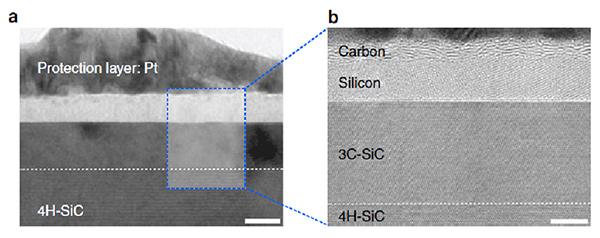UPDATES
IBS Center for Multidimensional Carbon Materials
Total : 62, Now : 9 page

A key advancement in the design of high performance carbon-based electronics
Pioneering research published in Nature by Professor Feng Ding's team from the Center for Multidimensional Carbon Materials, within the Institute for Basic Science (IBS), in collaboration with Professor Jin Zhang's team, at Peking University and colleagues, has demonstrated how to control the synthesis of special tiny carbon cylinders known as carbon nanotubes (CNTs), in order to synthesize horizontal arrays of CNTs with the same structure.
▲ Structure of carbon nanotube (CNT). (Left) Illustration of rolling graphene into CNTs of different structures, denoted by two indices, like (8,4). (Right) Microscope images of an array of CNTs with the mean diameter of 1.21 nm. Due to their exceptional mechanical, electrical and thermal properties, CNTs are considered an excellent alternative to silicon for next generation microelectronics. However, since CNTs' electron…
작성자 : CMCM
2017.02.18

UNIST faculty named among world's most influential scientific minds by Thomson Reuters.
Nov 17, 2016 / Joo Hyeon Heo / Public Relations Team / (c) UNIST
Two UNIST professors have distinguished themselves with inclusion in the 2016 list of Highly Cited Researchers, a yearly distinction released by Clarivate Analytics, formerly the Intellectual Property & Science business of Thomson Reuters. The report revealed that UNIST also recorded the most number of highly cited researchers in the field of materials science among research institutions in South Korea.
The latest Highly Cited Researcher listing by Thomson Reuters recognizes leading researchers in 21 fields of the sciences and social sciences from around the world. The new Thomson-Reuters list evaluated close to 130,000 highly cited papers in science and social sciences journals, indexed in the Web of Science Collection over an 11-year period from January 2004 to December 2014. Highly Cited Papers are defined as those that ra…
작성자 : CMCM
2016.12.22

IBS researchers disprove the idea that water degrades black phosphorus and find the materials is actually hydrophobic Researchers at the Center for Multidimensional Carbon Materials (CMCM), within the Institute for Basic Science (IBS) have discovered that one of graphene's competitors, black phosphorus, is inert to water deprived of oxygen, ending the debate of whether water causes its degradation. Their research, accepted by Chemistry of Materials, provides a more complete understanding of the role of molecular oxygen and water in the degradation of black phosphorus.Black phosphorus is a 2D materials structurlly similar to graphene with extraordinary electrical and optoelectric properties. However, unlike graphene, black phosphorus has the advantage of having a tunable bandgap. A bandgap is an energy barrier, essential for controlling the flow of electrons, like an on/off switch. Black phosphorus' bandgap varies depending on the number of black phosphorus layers: The more l…
작성자 : CMCM
2016.12.12

-IBS researchers report fundamental study of how graphene is hydrogenated-
Adding hydrogen
to graphene could improve its future applicability in the semiconductor
industry, when silicon leaves off. Researchers at the Center for Multidimensional
Carbon Materials (CMCM),
within the Institute for Basic Science (IBS) have recently gained
further insight into this chemical reaction. Published in Journal of the
American Chemical Society, these findings extend the knowledge of the
fundamental chemistry of graphene and bring scientists perhaps closer to
realizing new graphene-based materials.
Understanding how graphene can
chemically react with a variety of chemicals will increase its utility. Indeed,
graphene has superior conductivity properties, but it cannot be directly used
as an alternative to silicon in semiconductor electronics because it does not
have a bandgap, that is, its electrons can move without climbing any energy
barrier. Hydrogenation of graphene opens a …
작성자 : CMCM
2016.12.12

Making mark on global list of most cited, according to MSE SuppliesAug 17, 2016 / Joo Hyeon Heo / Public Relations Team (c) UNISTUNIST is well-represented 2016 List of Most Cited Researchers in Materials Science and Engineering (MSE) by Elsevier Scopus Data, appeared on the Academic Ranking of World Universities (ARWU) website on July 13th, 2016. Among all the researchers, only the top 300 in the field of materials science and engineering are included in the list ranked by the total citations of their papers. Being selected into the list of “Most Cited Researchers” means that these researchers have world-wide influence in their areas and their researching results also made distinguish contribute to the development of the area. UNST faculty on MSE Supplies highly cited list include Dr. Rodney S. Ruoff, Dr. Christopher W. Bielawski, and Dr. Jaephil Cho. Dr. Rodney S. Ruoff, Director of the Center for Multidimensional Carbon Materials (CMCM) at the Institute fo…
작성자 : CMCM
2016.12.05

Making Graphene Using Laser-induced Phase Separation - IBS & KAIST researchers clarify how laser annealing technology can lead to production of ultrathin nanomaterials - All our smart phones have shiny flat AMOLED displays. Behind each single pixel of these displays hide at least two silicon transistors which were mass-manufactured using laser annealing technologies. While the traditional methods to make them uses temperatures above 1,000°C, the laser technique reaches the same results at low temperatures even on plastic substrates (melting temperature below 300°C). Interestingly, a similar procedure can be used to generate crystals of graphene. Graphene is a strong and thin nano-material made of carbon, its electric and heat-conductive properties have attracted the attention of scientists worldwide.Prof. KEON Jae Lee's research group at the Center for Multidimensional Carbon Materials within the Institute for Basic Science (IBS) and Prof. CHOI Sung-Yool's team at …
작성자 : CMCM
2016.12.01
